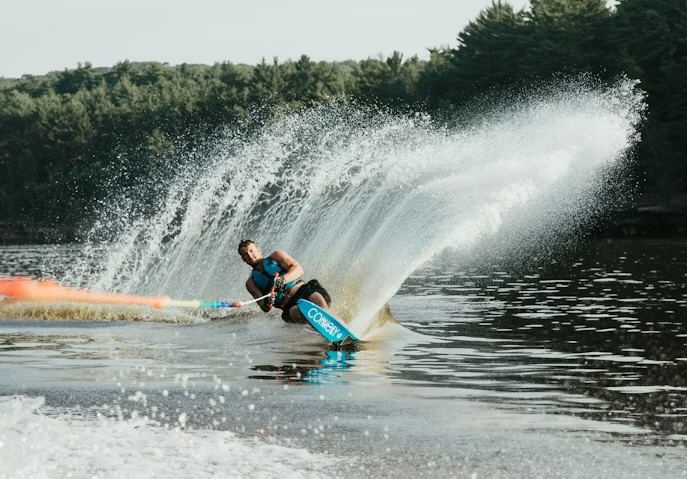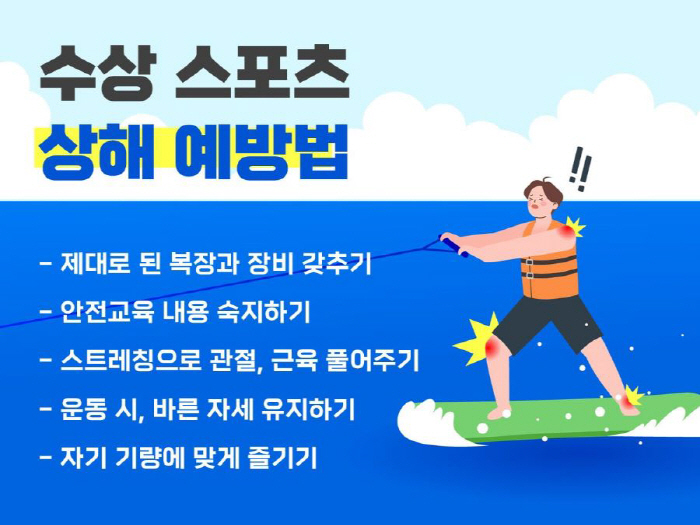Tips for enjoying water sports in summer
Aug 12, 2025
|
According to the Maritime Police Agency and the Ministry of Maritime Affairs and Fisheries' '2024 maritime accident statistics', 607 out of 3,255 maritime accidents were related to water leisure equipment, accounting for about 17.9%. In addition, as a result of the Korea Consumer Agency's analysis of water leisure safety accidents (2020-2022)', water leisure accidents occurred the most in August, and injuries caused by water skiing and surfing accounted for 68.7% of the total.
In fact, most water sports require intense physical activity, and they often have to balance and endure in an unstable posture, which easily puts a strain on joints and muscles. In addition, high speed, sudden change of direction, and collisions can lead to injuries such as muscle and ligament damage, dislocation, and rupture.
Kim Tae-seop, director of orthopedic surgery at Bupyeong Himchan Hospital, said, `A certain posture to maintain balance on water gives strength, and when a momentary impact is applied in a tense state, it is easy to injure muscles or joints"In order to enjoy it safely, it is important to understand the characteristics of the event and to maintain the correct posture by choosing an exercise that suits your level."
◇ Water sports, strong shocks and pressures are delivered...the possibility of joint damage
Water skiing and wakeboarding are sports that slide on the surface of the water while holding a rope connected to a motorboat. You can enjoy the sense of speed by moving quickly on the water, but that's how strong impact and pressure are applied to the body. You have to balance your body so that you don't fall, so your whole body is strengthened. In the process of holding on to the rope, rotator cuff damage can occur as the arm and shoulder strain. If the rotator cuff surrounding the shoulder is damaged, the shoulder feels stiff. Mainly, pain is felt in the front of the shoulder and the outer part of the arm, and shoulder pain is felt when the arm is turned back or when sleeping. When the rotator cuff ruptures during rotator cuff injury, extreme pain is felt when lifting or moving the arm.
Popular surfing paddles while lying face down and uses a lot of shoulder muscles, which can cause fatigue accumulation and inflammation in the shoulders. If shoulder pain occurs during water leisure, you should refrain from unreasonable movements and rest because shoulder pain after exercise may develop into a rotator cuff rupture that breaks tendons.
In particular, torsion of the knee joint can occur on water, which can lead to cruciate ligament or meniscus cartilage damage. Damage occurs when you lose your balance and fall down, or when your knees are slightly bent and rotate excessively. The meniscus cartilage is a fibrous cartilage between the bones above and below the knee that absorbs shock and protects the knee joint. When the meniscus cartilage is damaged, knee pain, swelling, and knee seem to be submerged. It is very important to accurately diagnose and treat knee injuries early on when they are first damaged.
◇ Correct posture and stretching are important...Examination is required if pain or swelling gets worse
The most common cause of exercise injuries is neglect of practice. It is a big problem to suddenly learn too much through short daily classes during the holiday season and ride too much rather than your skills. First of all, it is also important to be well equipped with clothes and equipment to prevent injury. It is also necessary to receive and protect water sports safety. Above all, pre-warming exercises are essential to prevent injuries to intense systemic exercises. Sufficient stretching and relaxation exercises should be performed around major joint areas to ensure flexibility of joints and muscles.
When enjoying water skiing or wakeboarding, it is important to bend your knees slightly to take a horseback riding position and to stare at the front of your upper body. Holding on with the strength of the lower body and core muscles rather than the strength of the arms and shoulders helps reduce injuries. When landing, bend your knees sufficiently to disperse the impact, and when you fall, you should pull your chin and curl up to minimize the impact of colliding with water.
For surfing, it is recommended to do shoulder stretching and rotator cuff strengthening exercises in advance. In addition, when standing up on the board, you should relieve the burden on your back by practicing focusing on your abdominal strength and lower body. You should choose a wave that suits your skills and keep your distance from the surfers around you to prevent collisions.
If an injury occurs in the joint area, first aid is needed. Rest enough without moving the injured area and cool down with an ice bag for 15-20 minutes to relieve pain and swelling. It prevents swelling by lightly compressing the injured area with a bandage or compression band.
Kim Tae-seop, Director of Orthopedic Surgery at Bupyeong Himchan Hospital, said "If the pain does not subside within a few days, or if it gets worse, it may not be just muscle pain."If pain is left unattended, it can lead to chronic pain or dysfunction, so initial response is important, and if the injured area is swollen and you feel hot, it is better to deal with it with a cold compress."
|
This article was translated by Naver AI translator.















